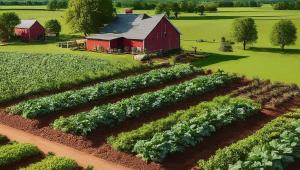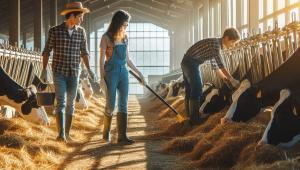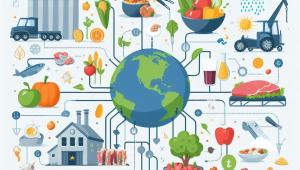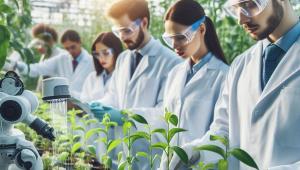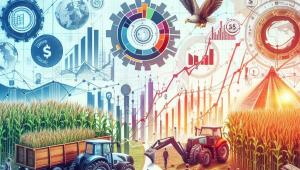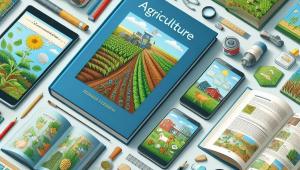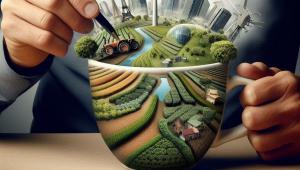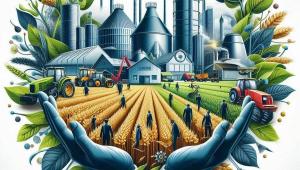Agriculture is one of the most essential human activities, providing food, fiber, and other products that sustain and enhance human life. However, agriculture also has significant environmental impacts, both positive and negative, on the natural resources and ecosystems that support it. As the global population grows and the demand for agricultural products increases, managing the environmental impact of agriculture has become a critical challenge for farmers, policymakers, and society as a whole.
Land Use and Biodiversity
Agriculture is the largest user of land globally, occupying about 38% of the Earth's land surface. The conversion of natural habitats, such as forests, grasslands, and wetlands, to agricultural land has significant impacts on biodiversity, ecosystem services, and carbon storage.
Deforestation and Habitat Loss
Deforestation, or the clearing of forests for agricultural expansion, is one of the most significant environmental impacts of agriculture. Forests are critical habitats for biodiversity, providing food, shelter, and other resources for a wide range of plant and animal species. Deforestation not only directly reduces species populations and habitat availability but also fragments the remaining habitats, making them more vulnerable to edge effects, invasive species, and other disturbances.
The extent and rate of deforestation vary across regions and agricultural systems. For example, in the Amazon rainforest, cattle ranching and soybean production are the main drivers of deforestation, while in Southeast Asia, oil palm plantations and smallholder agriculture are the primary causes of forest loss. The impacts of deforestation also vary depending on the scale, intensity, and location of the agricultural activities, as well as the ecological and socioeconomic context of the region.
Strategies for reducing deforestation and habitat loss from agriculture include:
- Increasing agricultural productivity and efficiency on existing land, through improved crop varieties, management practices, and technologies, to reduce the need for agricultural expansion.
- Promoting agroforestry and other integrated land use systems that combine agricultural production with forest conservation and restoration.
- Strengthening forest governance and land tenure security, to provide incentives for sustainable forest management and discourage illegal or unsustainable deforestation.
- Implementing market-based mechanisms, such as certification schemes and payment for ecosystem services, to create economic incentives for forest conservation and sustainable agriculture.
Soil Degradation and Erosion
Soil is a critical resource for agriculture, providing the foundation for plant growth, nutrient cycling, and water retention. However, agricultural practices can also degrade soil quality and accelerate soil erosion, reducing the productivity and sustainability of agricultural systems.
Soil degradation refers to the decline in soil quality and function due to factors such as nutrient depletion, acidification, salinization, compaction, and contamination. These factors can be caused by unsustainable agricultural practices, such as overgrazing, monocropping, and excessive tillage, as well as by external factors, such as climate change and urbanization.
Soil erosion refers to the removal of topsoil by water, wind, or other agents, which can reduce soil fertility, water holding capacity, and crop yields. Soil erosion is a natural process, but it can be accelerated by human activities, such as deforestation, overgrazing, and intensive tillage, which expose the soil surface to erosive forces.
The impacts of soil degradation and erosion vary across regions and agricultural systems, depending on factors such as soil type, topography, climate, and land use intensity. For example, in arid and semi-arid regions, such as the Sahel and the Middle East, soil salinization and desertification are major challenges, while in humid tropical regions, such as Southeast Asia and the Amazon, soil acidification and nutrient depletion are more prevalent.
Strategies for reducing soil degradation and erosion from agriculture include:
- Adopting conservation agriculture practices, such as reduced tillage, cover cropping, and crop rotation, which protect the soil surface, increase soil organic matter, and improve soil structure and fertility.
- Implementing soil and water conservation measures, such as terracing, contour farming, and agroforestry, which reduce soil erosion and enhance water retention and infiltration.
- Promoting integrated nutrient management, which combines organic and inorganic nutrient sources, and matches nutrient application with crop needs and soil properties, to optimize nutrient use efficiency and minimize nutrient losses.
- Strengthening extension services and farmer education, to provide knowledge and skills on sustainable soil management practices, and to promote adaptive and context-specific solutions.
Agrobiodiversity and Genetic Erosion
Agrobiodiversity refers to the diversity of crop and livestock species, as well as their wild relatives and associated biodiversity, that are used in agriculture. Agrobiodiversity is essential for food security, nutrition, and resilience, providing the genetic resources for breeding new crop varieties and adapting to changing environmental and market conditions.
However, the industrialization and globalization of agriculture have led to a significant loss of agrobiodiversity, as farmers shift from traditional, diverse farming systems to modern, simplified systems based on a few high-yielding crop varieties and livestock breeds. This process, known as genetic erosion, reduces the genetic diversity and adaptability of agricultural systems, making them more vulnerable to pests, diseases, and climate change.
The extent and rate of genetic erosion vary across regions and agricultural systems, depending on factors such as market demand, agricultural policies, and cultural preferences. For example, in the Andes, where potatoes originated and were domesticated, the number of potato varieties has declined from several thousand to a few hundred, as farmers adopt modern varieties and abandon traditional ones. Similarly, in Southeast Asia, the number of rice varieties has declined by 90% in some areas, as farmers shift to high-yielding varieties promoted by the Green Revolution.
Strategies for conserving and enhancing agrobiodiversity include:
- Promoting in situ conservation of crop and livestock diversity, through the maintenance and use of traditional varieties and breeds by farmers, and the protection of wild relatives and associated biodiversity in natural habitats.
- Establishing ex-situ conservation facilities, such as gene banks and botanical gardens, to collect, characterize, and conserve the genetic resources of crops and livestock, and to make them available for research and breeding.
- Developing participatory plant breeding and livestock breeding programs, which involve farmers in the selection and improvement of locally adapted varieties and breeds, based on their knowledge, preferences, and conditions.
- Creating market incentives for agrobiodiversity conservation and use, through certification schemes, geographical indications, and other value chain interventions, which recognize and reward the cultural and ecological values of traditional agricultural products.
Water Use and Quality
Agriculture is the largest user of freshwater globally, accounting for about 70% of total water withdrawals. The increasing demand for irrigation, coupled with the impacts of climate change and land use change, is putting pressure on water resources and ecosystems, and creating challenges for agricultural sustainability and water security.
Irrigation and Water Scarcity
Irrigation is the artificial application of water to crops, to supplement or replace rainfall, and to increase crop yields and quality. Irrigation is essential for food security and rural livelihoods in many regions, particularly in arid and semi-arid areas, where rainfall is insufficient or unreliable.
However, irrigation can also have significant environmental impacts, such as:
- Depleting aquifers and surface water sources, due to unsustainable water withdrawals and inefficient water use, leading to water scarcity and competition with other water users, such as cities and industries.
- Altering hydrological cycles and ecosystem functions, by changing the timing, magnitude, and quality of water flows, and by reducing the connectivity and diversity of aquatic habitats.
- Contributing to soil salinization and waterlogging, by applying excessive or poor-quality water, and by inadequate drainage and leaching of salts, leading to reduced crop yields and land degradation.
The extent and severity of these impacts vary across regions and irrigation systems, depending on factors such as water availability, irrigation technology, crop types, and management practices. For example, in the Aral Sea basin in Central Asia, the expansion of cotton irrigation led to the desiccation of the Aral Sea, the salinization of the surrounding land, and the decline of the fishing industry and local livelihoods. In contrast, in the Nile Delta in Egypt, the use of drip irrigation and drainage systems has allowed for the sustainable intensification of agriculture, while minimizing water losses and soil degradation.
Strategies for improving the sustainability and efficiency of irrigation include:
- Adopting water-saving irrigation technologies, such as drip irrigation, micro-sprinklers, and soil moisture sensors, which apply water directly to the crop root zone, and minimize evaporation and runoff losses.
- Implementing irrigation scheduling and precision agriculture, which match water application with crop water requirements and soil moisture levels, based on real-time data and decision support tools.
- Promoting water pricing and market-based instruments, which create incentives for water conservation and allocation, and reflect the full cost and value of water resources.
- Developing integrated water resources management (IWRM) approaches, which coordinate the management of water, land, and related resources across sectors and scales, to optimize economic and social welfare, while ensuring the sustainability of ecosystems.
Water Pollution and Eutrophication
Agricultural activities can also contribute to water pollution and eutrophication, by releasing nutrients, pesticides, and other contaminants into water bodies, through surface runoff, leaching, and atmospheric deposition. These pollutants can have harmful effects on aquatic ecosystems, human health, and economic activities, such as fishing and tourism.
Nutrients, such as nitrogen and phosphorus, are essential for plant growth and soil fertility, but their excessive use and loss can lead to water quality problems, such as:
- Eutrophication, or the enrichment of water bodies with nutrients, leading to the growth of algae and other aquatic plants, the depletion of dissolved oxygen, and the die-off of fish and other aquatic organisms.
- Nitrate contamination of groundwater, which can pose health risks, such as methemoglobinemia (blue baby syndrome) and cancer, when used for drinking water.
- Acidification of surface water, by the deposition of nitrogen oxides and ammonia from agricultural sources, leading to the decline of acid-sensitive species and the alteration of ecosystem processes.
Pesticides, such as insecticides, herbicides, and fungicides, are used to control pests and diseases in crops and livestock, but their overuse and misuse can also have negative impacts on water quality and aquatic life, such as:
- Toxicity to non-target species, such as fish, invertebrates, and amphibians, leading to population declines and ecosystem imbalances.
- Bioaccumulation and biomagnification in food chains, as persistent pesticides accumulate in the tissues of organisms and increase in concentration at higher trophic levels.
- Resistance development in target pests, leading to the need for higher doses or new pesticides, and increasing the risk of environmental and health impacts.
The extent and severity of water pollution from agriculture vary across regions and agricultural systems, depending on factors such as climate, soil type, crop type, and management practices. For example, in the Mississippi River basin in the United States, the intensive use of fertilizers and animal manure in corn and soybean production has led to the formation of a "dead zone" in the Gulf of Mexico, where oxygen levels are too low to support marine life. In contrast, in the Rhine River basin in Europe, the implementation of nutrient management and pesticide reduction policies has led to a significant improvement in water quality and ecological status.
Strategies for reducing water pollution from agriculture include:
- Implementing nutrient management plans, which optimize the rate, timing, and placement of fertilizers and manure, based on crop needs, soil properties, and weather conditions, to minimize nutrient losses and maximize nutrient use efficiency.
- Adopting integrated pest management (IPM) practices, which combine biological, cultural, and chemical control methods, and use pesticides as a last resort, based on economic thresholds and resistance management.
- Establishing buffer zones and riparian areas, which intercept and filter surface runoff and subsurface flow, and provide habitat for biodiversity and ecosystem services.
- Promoting precision agriculture and variable rate application technologies, which apply inputs at the right rate, time, and place, based on site-specific data and decision support tools.
Climate Change and Greenhouse Gas Emissions
Agriculture is both a contributor to and a victim of climate change, as agricultural activities emit greenhouse gases (GHGs) that warm the planet, while climate change impacts, such as rising temperatures, changing precipitation patterns, and extreme weather events, affect agricultural production and food security.
Agricultural Greenhouse Gas Emissions
Agriculture is a significant source of GHG emissions, accounting for about 10-12% of global anthropogenic emissions. The main agricultural GHGs are:
- Carbon dioxide (CO2), released from the burning of fossil fuels, the clearing of forests and other land use changes, and the decomposition of soil organic matter.
- Methane (CH4), produced by the enteric fermentation of ruminant livestock, the anaerobic decomposition of organic matter in flooded rice fields and manure management, and the incomplete combustion of biomass.
- Nitrous oxide (N2O), emitted from the microbial processes of nitrification and denitrification in soils, the application of nitrogen fertilizers and manure, and the burning of biomass.
The relative contribution and importance of these GHGs vary across regions and agricultural systems, depending on factors such as climate, soil type, crop and livestock type, and management practices. For example, in Sub-Saharan Africa, where livestock production is a major source of livelihoods and income, enteric fermentation and manure management are the main sources of agricultural GHG emissions. In contrast, in Southeast Asia, where rice is a staple crop and a major source of methane emissions, flooded rice cultivation and the burning of rice straw are the main sources of agricultural GHGs.
Strategies for reducing agricultural GHG emissions include:
- Improving the efficiency of livestock production, through breeding, feeding, and health management practices that reduce enteric fermentation and manure emissions per unit of output.
- Adopting anaerobic digestion and other manure management technologies, which capture and utilize methane for energy production, and reduce the environmental and health impacts of manure storage and application.
- Implementing alternate wetting and drying (AWD) and other water management practices in rice production, which reduce methane emissions by aerating the soil and promoting the growth of methanotrophic bacteria.
- Promoting agroforestry and other land use systems that sequester carbon in biomass and soils, and provide other ecosystem services, such as biodiversity conservation and water regulation.
Climate Change Impacts on Agriculture
Climate change is already affecting agriculture in many regions, through changes in temperature, precipitation, and the frequency and intensity of extreme weather events. These impacts can have both positive and negative effects on crop and livestock production, depending on the region, the agricultural system, and the adaptive capacity of farmers and communities.
Some of the main climate change impacts on agriculture include:
- Rising temperatures, which can increase the risk of heat stress, water scarcity, and pest and disease outbreaks, and reduce the yield and quality of many crops, particularly in tropical and subtropical regions.
- Changing precipitation patterns, which can increase the variability and unpredictability of rainfall, and the risk of droughts and floods, affecting the availability and quality of water for irrigation and rainfed agriculture.
- Extreme weather events, such as hurricanes, hailstorms, and wildfires, which can damage crops, livestock, and infrastructure, and disrupt food supply chains and markets.
- Sea level rise and saltwater intrusion, which can salinize coastal aquifers and soils, and reduce the productivity and suitability of agricultural land in low-lying areas.
The vulnerability and resilience of agriculture to climate change vary across regions and agricultural systems, depending on factors such as the exposure and sensitivity to climate hazards, the adaptive capacity and resources of farmers and communities, and the policies and institutions that support climate change adaptation and mitigation.
Strategies for adapting agriculture to climate change include:
- Developing and disseminating climate-resilient crop varieties and livestock breeds, which can tolerate heat, drought, salinity, and other stresses, and maintain yield and quality under changing climatic conditions.
- Implementing climate-smart agriculture practices, such as conservation agriculture, agroforestry, and integrated crop-livestock systems, which increase the resilience and productivity of agricultural systems, while reducing GHG emissions and enhancing carbon sequestration.
- Promoting crop and livelihood diversification, which can reduce the risk and vulnerability of farmers to climate shocks and market fluctuations, and increase their adaptive capacity and income opportunities.
- Strengthening climate information services and early warning systems, which can provide timely and relevant information to farmers and policymakers, and support proactive and informed decision-making for climate change adaptation and disaster risk management.
Strategies and Solutions for Sustainable Agriculture
Achieving sustainable agriculture requires a holistic and integrated approach that balances the economic, social, and environmental dimensions of agricultural systems, and involves the participation and collaboration of multiple stakeholders, including farmers, researchers, policymakers, and consumers.
Some of the key strategies and solutions for sustainable agriculture include:
Agroecology and Regenerative Agriculture
Agroecology is a scientific and social movement that applies ecological principles and traditional knowledge to the design and management of agricultural systems, with the aim of enhancing their productivity, resilience, and sustainability. Agroecology emphasizes the use of natural processes and local resources, such as biodiversity, nutrient cycling, and soil health, and the integration of social and cultural values, such as food sovereignty, farmer empowerment, and traditional knowledge.
Regenerative agriculture is a related approach that focuses on the regeneration of soil health, biodiversity, and ecosystem services, through practices such as no-till farming, cover cropping, crop rotation, and holistic grazing management. Regenerative agriculture aims to restore degraded lands, sequester carbon in soils and biomass, and create more resilient and productive agricultural systems.
Both agroecology and regenerative agriculture offer promising solutions for reducing the environmental impact of agriculture, while enhancing food security, livelihoods, and well-being. However, they also face challenges, such as the need for knowledge-intensive management, the lack of supportive policies and markets, and the resistance from dominant agricultural paradigms and interests.
Sustainable Intensification and Precision Agriculture
Sustainable intensification is an approach that aims to increase agricultural productivity and efficiency, while minimizing environmental impacts and resource use. Sustainable intensification involves the use of technologies and practices that optimize the use of inputs, such as water, nutrients, and energy, and maximize the output of crops and livestock, based on site-specific conditions and needs.
Precision agriculture is a set of technologies and practices that enable farmers to manage crops and livestock with greater precision and efficiency, based on data and decision support tools. Precision agriculture involves the use of sensors, drones, satellites, and other tools to collect and analyze data on soil properties, plant health, animal behavior, and other variables, and to apply inputs and management practices at the right rate, time, and place.
Both sustainable intensification and precision agriculture offer opportunities for increasing agricultural productivity and sustainability, particularly in regions with limited land and water resources, and high population growth and food demand. However, they also face challenges, such as the high cost and complexity of the technologies, the need for capacity building and infrastructure, and the potential for social and economic exclusion of small-scale and resource-poor farmers.
Circular and Bio-based Economy
The circular economy is an economic model that aims to close the loop of resource use and waste generation, by designing products and systems that are renewable, reusable, and recyclable. In agriculture, the circular economy involves the use of biomass and waste streams as feedstocks for the production of food, feed, energy, and other bio-based products, and the recycling of nutrients and water back into the agricultural system.
The bio-based economy is a related concept that focuses on the production and use of renewable biological resources, such as crops, trees, and microorganisms, as substitutes for fossil-based resources, such as oil, coal, and gas. The bio-based economy aims to create new value chains and markets for sustainable and climate-friendly products, such as biofuels, bioplastics, and biochemicals.
Both the circular and bio-based economy offer opportunities for reducing the environmental impact of agriculture, while creating new economic opportunities and jobs in rural areas. However, they also face challenges, such as the competition for land and biomass resources, the need for infrastructure and logistics, and the potential for negative social and environmental impacts, such as land grabbing and biodiversity loss.
Policies and Institutions for Sustainable Agriculture
Achieving sustainable agriculture requires supportive policies and institutions that create incentives and enabling conditions for the adoption and scaling of sustainable practices and technologies. Some of the key policy and institutional strategies for sustainable agriculture include:
- Integrating sustainability criteria and metrics into agricultural policies and programs, such as subsidies, taxes, and regulations, to encourage the adoption of sustainable practices and discourage unsustainable ones.
- Investing in research and innovation for sustainable agriculture, particularly in public goods and services, such as agroecology, climate change adaptation, and ecosystem services, and in participatory and transdisciplinary approaches that engage farmers and other stakeholders.
- Strengthening extension and advisory services for sustainable agriculture, particularly in the delivery of context-specific and demand-driven information and support to farmers, and in the facilitation of farmer-to-farmer learning and innovation.
- Promoting sustainable and inclusive value chains and markets, particularly through certification schemes, public procurement, and other market-based instruments that reward sustainable practices and products, and that ensure fair prices and benefits for farmers and workers.
- Enhancing governance and coordination for sustainable agriculture, particularly through multi-stakeholder platforms and partnerships that bring together different actors and sectors, and that enable dialogue, learning, and collective action for sustainable agriculture.
Conclusion
Agriculture is a major driver of environmental change, with significant impacts on land use, biodiversity, water resources, and climate change. At the same time, agriculture is also highly vulnerable to environmental change, as it depends on natural resources and ecosystem services for its productivity and resilience.
Managing the environmental impact of agriculture is a complex and urgent challenge that requires a systemic and transformative approach, involving multiple strategies, solutions, and stakeholders. Some of the key strategies and solutions for sustainable agriculture include agroecology and regenerative agriculture, sustainable intensification and precision agriculture, circular and bio-based economy, and supportive policies and institutions.
Achieving sustainable agriculture is not only an environmental imperative but also a social and economic one, as it is essential for ensuring food security, livelihoods, and well-being for current and future generations. Sustainable agriculture is also a key component of the broader sustainability agenda, as it is interconnected with other global challenges, such as poverty, inequality, health, and climate change.
However, achieving sustainable agriculture is not easy, as it involves trade-offs, uncertainties, and resistance from vested interests and dominant paradigms. It requires a fundamental shift in the way we think about and value agriculture, from a narrow focus on productivity and profitability to a more holistic and inclusive perspective that recognizes the multiple functions and values of agriculture, and the need for a more equitable and resilient food system.
To achieve sustainable agriculture, we need to:
- Recognize and value the diversity and complexity of agricultural systems, and the knowledge and innovations of farmers and indigenous communities, as key assets for sustainable agriculture.
- Invest in research, education, and extension for sustainable agriculture, particularly in agroecology, climate change adaptation, and ecosystem services, and in participatory and transdisciplinary approaches that engage farmers and other stakeholders.
- Promote policies and institutions that create incentives and enabling conditions for sustainable agriculture, particularly through market-based instruments, public procurement, and multi-stakeholder partnerships.
- Empower and support farmers and rural communities, particularly women, youth, and marginalized groups, as key agents of change for sustainable agriculture, through access to resources, services, and decision-making.
- Foster a culture of sustainability and responsibility in the food system, particularly through consumer awareness, education, and engagement, and through the promotion of healthy and sustainable diets.
Sustainable agriculture is not a one-size-fits-all solution, but rather a context-specific and adaptive process that requires continuous learning, innovation, and collaboration. It is a journey that involves challenges and opportunities, but also great potential for creating a more sustainable, equitable, and resilient food system for all.
As we face the challenges of the 21st century, sustainable agriculture is not an option but a necessity, and a key pathway for achieving the Sustainable Development Goals and the Paris Agreement on climate change. It is a call to action for all of us, as citizens, consumers, and stakeholders, to work together towards a more sustainable and just future for agriculture and food systems.
